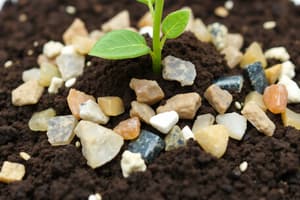Podcast
Questions and Answers
What is the primary role of carbon fixation in plants?
What is the primary role of carbon fixation in plants?
- To absorb essential minerals from the soil.
- To facilitate the uptake of water through the roots.
- To convert light energy into chemical energy in the form of carbohydrates. (correct)
- To repair damaged plant tissues.
Which of the following best describes the role of primary metabolites in plants?
Which of the following best describes the role of primary metabolites in plants?
- They are involved in defense mechanisms against herbivores.
- They play an indirect role in plant survival under stress.
- They facilitate the uptake of water and nutrients from the soil.
- They directly contribute to the plant's growth, development, and reproduction. (correct)
What is the main function of secondary metabolites in plants?
What is the main function of secondary metabolites in plants?
- Directly contributing to the plant's growth rate.
- Aiding in the transport of water and minerals.
- Converting sunlight into chemical energy.
- Interacting with the environment to enhance survival and reproduction. (correct)
How do plants primarily obtain mineral nutrients from the soil?
How do plants primarily obtain mineral nutrients from the soil?
What is the significance of cation exchange in plant nutrition?
What is the significance of cation exchange in plant nutrition?
How do mycorrhizal fungi benefit plants?
How do mycorrhizal fungi benefit plants?
Carnivory and parasitism can be considered nutritive strategies in plants. What is the primary difference between them?
Carnivory and parasitism can be considered nutritive strategies in plants. What is the primary difference between them?
Which of the following is an example of mutualism in plant nutrition?
Which of the following is an example of mutualism in plant nutrition?
Which of the following best describes the relationship between magnesium and chlorophyll in plants?
Which of the following best describes the relationship between magnesium and chlorophyll in plants?
If a plant exhibits nutrient deficiency symptoms primarily in older leaves, this indicates the nutrient is:
If a plant exhibits nutrient deficiency symptoms primarily in older leaves, this indicates the nutrient is:
What is the primary role of primary metabolites in plant nutrition and growth?
What is the primary role of primary metabolites in plant nutrition and growth?
A plant is developing new stems and leaves through its axillary buds. This is most directly related to which aspect of plant nutrition?
A plant is developing new stems and leaves through its axillary buds. This is most directly related to which aspect of plant nutrition?
The assimilation of new elements (nutrients) is most directly required for what plant process?
The assimilation of new elements (nutrients) is most directly required for what plant process?
Which of the following is NOT a primary function of soil for plants?
Which of the following is NOT a primary function of soil for plants?
A farmer observes that their soil is waterlogged and has poor aeration. Which component of soil is most likely affected, leading to these conditions?
A farmer observes that their soil is waterlogged and has poor aeration. Which component of soil is most likely affected, leading to these conditions?
What differentiates the 'O horizon' from the 'A horizon' in a typical soil profile?
What differentiates the 'O horizon' from the 'A horizon' in a typical soil profile?
Which of the following best describes the primary role of micronutrients in plants?
Which of the following best describes the primary role of micronutrients in plants?
A plant exhibits stunted growth, yellowing leaves, and a general lack of vigor. Which of the following deficiencies is MOST likely responsible for these symptoms?
A plant exhibits stunted growth, yellowing leaves, and a general lack of vigor. Which of the following deficiencies is MOST likely responsible for these symptoms?
How does the role of a macronutrient differ from that of a micronutrient in plant nutrition?
How does the role of a macronutrient differ from that of a micronutrient in plant nutrition?
What describes the potential consequence of a plant lacking the micronutrient molybdenum (Mo)?
What describes the potential consequence of a plant lacking the micronutrient molybdenum (Mo)?
A scientist is analyzing a plant that shows signs of nutrient deficiency. They determine that the plant is deficient in a nutrient that is highly mobile within the plant. Where would the deficiency symptoms MOST likely appear?
A scientist is analyzing a plant that shows signs of nutrient deficiency. They determine that the plant is deficient in a nutrient that is highly mobile within the plant. Where would the deficiency symptoms MOST likely appear?
Which nutrient deficiency would MOST directly affect the synthesis of proteins within a plant?
Which nutrient deficiency would MOST directly affect the synthesis of proteins within a plant?
Which of the following is the MOST accurate distinction between primary and secondary metabolites in plant nutrition?
Which of the following is the MOST accurate distinction between primary and secondary metabolites in plant nutrition?
A farmer observes that their tomato plants are producing fruits with blossom end rot (a dark, sunken area at the bottom of the fruit). Which nutrient deficiency is MOST likely the cause?
A farmer observes that their tomato plants are producing fruits with blossom end rot (a dark, sunken area at the bottom of the fruit). Which nutrient deficiency is MOST likely the cause?
If a plant is unable to produce secondary metabolites due to a micronutrient deficiency, what is the MOST likely consequence?
If a plant is unable to produce secondary metabolites due to a micronutrient deficiency, what is the MOST likely consequence?
A plant displays chlorosis (yellowing) in its young leaves. This symptom is MOST likely associated with a deficiency in which type of nutrient?
A plant displays chlorosis (yellowing) in its young leaves. This symptom is MOST likely associated with a deficiency in which type of nutrient?
Flashcards
Essential Nutrients
Essential Nutrients
Nutrients necessary for the structure and function of multicellular organisms.
Nutrient Absorption
Nutrient Absorption
Process by which organisms acquire nutrients through roots.
Carbon Fixation
Carbon Fixation
Process where plants convert CO2 into carbohydrates using light.
Primary Metabolites
Primary Metabolites
Signup and view all the flashcards
Secondary Metabolites
Secondary Metabolites
Signup and view all the flashcards
Cation Exchange
Cation Exchange
Signup and view all the flashcards
Mycorrhizal Fungi
Mycorrhizal Fungi
Signup and view all the flashcards
Nutritive Strategies
Nutritive Strategies
Signup and view all the flashcards
Magnesium Function
Magnesium Function
Signup and view all the flashcards
Nutrient Mobility
Nutrient Mobility
Signup and view all the flashcards
Soil Composition
Soil Composition
Signup and view all the flashcards
Major Soil Horizons
Major Soil Horizons
Signup and view all the flashcards
Functions of Soil
Functions of Soil
Signup and view all the flashcards
Plant Growth Process
Plant Growth Process
Signup and view all the flashcards
Macronutrients
Macronutrients
Signup and view all the flashcards
Micronutrients
Micronutrients
Signup and view all the flashcards
Nutrient deficiency symptoms
Nutrient deficiency symptoms
Signup and view all the flashcards
Coenzymes
Coenzymes
Signup and view all the flashcards
Enzyme cofactors
Enzyme cofactors
Signup and view all the flashcards
Minerals
Minerals
Signup and view all the flashcards
Plant nutrition
Plant nutrition
Signup and view all the flashcards
Study Notes
Course Information
- Course: BIOL 206
- Topic: Nutrition in Plants
- Instructor: Dr. Jason Lambert
- Office Hours: BI 365, 2:00pm - 4:00pm
- Email: [email protected]
Learning Objectives
- Identify and describe essential nutrients for multicellular organisms
- Explain how multicellular organisms acquire nutrients
- Describe nutrient absorption and processing
- Explain various nutritive strategies, including symbiotic relationships
Outline
- Quick Review: Plant Organs/Organ Systems and their functions
- Definitions: Carbon Fixation, Metabolites, Macronutrients/Micronutrients, Soil Composition
- Source of mineral and organic nutrients in soil
- Nutrient absorption in roots (Cations and Anions, Cation Exchange)
- Mutualism (Mycorrhizal fungi, Bacteria)
- Nutritive Strategies in plants: Carnivory, Parasitism
Quick Review: Plant Organs/Organ Systems and their functions
- Students should identify numbered parts of a plant (roots, leaves, stem)
- Students should determine the substances moving into and out of each identified part
Plant Nutrition: Definitions
- Carbon Fixation: the process plants utilize to "fix" or attach carbon atoms together to form carbohydrates
- 6CO₂ + 6H₂O + light → C₆H₁₂O₆ + 6O₂
- Carbons from this process form the basis for building other complex molecules and energy production
Molecules made by plants
- Primary metabolites: Directly contribute to growth and reproduction
- Secondary metabolites: Indirectly influence growth and survival/reproduction through interactions with the environment
Substances needed by plants
- Macronutrients: needed in high quantities, used to manufacture primary and secondary metabolites
- Micronutrients: necessary in smaller quantities, serve as enzymes or cofactors involved in the production of secondary metabolites
Nutritional needs of Plants and Animals
- Raw material for building macromolecules (Table presenting plant and animal needs)
Soil
- Unconsolidated, biologically active medium containing biotic and abiotic components
- Upper limit: air/shallow water
- Lower limit: bedrock/consolidated material
- Soil properties (mechanical support, mineral nutrients, water, oxygen)
- Major Soil Horizons (O, A, B, C horizons)
- Soil formation from wind, temperature, rain, and organisms breaking down solid rock
- Soil texture categories: Gravel, Sand, Silt, Clay
- Loam: ideal topsoil with nearly equal proportions of sand, silt, and clay
Nutrient Absorption
- Mineral nutrients are often present as ions in the soil
- Cations are positive and interact with negative charges on clay particles, while Anions dissolve in water
- Cation exchange process described and diagrammed where H+ from roots displace other mineral cations to make them available
- Various methods for absorbing mineral nutrients (proton pumps, channels, cotransporters); absorption routes (symplastic route, transmembrane route, apoplastic route). Materials move from root hair through different parts of the plant, including the xylem.
Mutualism: Fungi & Bacteria
- Plants benefit by obtaining phosphorus and nitrogen through mutualistic relationships with fungi and bacteria
- Fungi and Bacteria:
- Exchange sugars and amino acids/phosphates for nutrient access
- Form extensive networks throughout the soil (hyphae)
- Breakdown dead organic matter to release nutrients
- Nitrogen-fixing bacteria convert atmospheric nitrogen to ammonia/ammonium ions
- Mycorrhizae: Fungal hyphae associated with plant roots
- Ectomycorrhizae: Hyphae encircle plant roots, but don't penetrate cell walls
- Arbuscular mycorrhizae: Hyphae penetrate plant cell walls and form highly branched structures
- Nodules on root: Bacteria inhabit these
- Leghemoglobin: Protein in nodules that binds oxygen, allowing the bacteria to perform aerobic respiration
Nutritive Strategies
- Carnivory: Trapping and digesting insects, common in acidic, nutrient-poor environments (bogs)
- Parasitism: Obtaining water, minerals, and/or sugars from other organisms (haustoria - specialized structures for absorption)
Studying That Suits You
Use AI to generate personalized quizzes and flashcards to suit your learning preferences.




